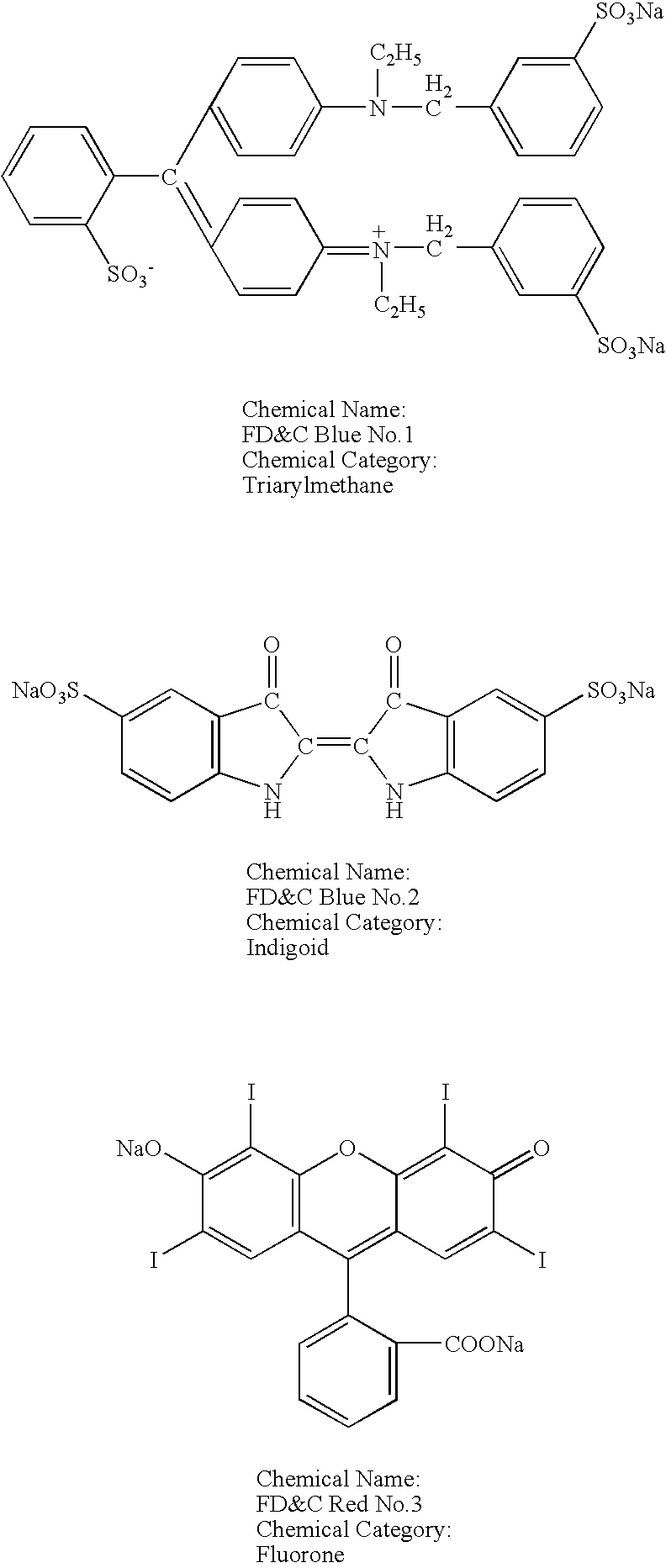Aqueous Antiseptic Solution and Compatible Cationic Dye for Staining Skin
- Summary
- Abstract
- Description
- Claims
- Application Information
AI Technical Summary
Benefits of technology
Problems solved by technology
Method used
Image
Examples
example 1
[0035] The compatibility of an anionic dye alone with an aqueous CHG solution (i.e., without the addition of a cationic excipient) was tested. A 0.13% w / v anionic dye solution was prepared by dissolving 0.13 g FD&C Yellow 6 in 100 ml of distilled water. A 20% w / v aqueous CHG solution was then added drop wise to the dye solution. After two drops of the aqueous CHG solution were added to the dye solution, precipitant was formed, demonstrating the incompatibility of the dye alone with the aqueous CHG solution.
example 2
[0036] To test the compatibility of anionic dyes and cationic excipients, a number of solutions were prepared with different anionic dyes and cationic excipients. The cationic excipients tested included: CPC, hexadecyl trimethyl ammonium bromide, benzethonium chloride, and benzalkonium chloride. The anionic dyes tested included: FD&C Green No. 3 (Fast Green FCF), FD&C Yellow No. 5 (Tartrazine), FD&C Red No. 40 (Allura Red), FD&C Yellow No. 6 (Sunset Yellow FCF), FD&C Blue No. 1 (Brilliant Blue FCF), FD&C Blue No. 2 (Indigo Carmine), and FD&C Red No. 3 (Erythrosine). The chemical structure and chemical category of each of these dyes are presented below.
[0037] The compatibility of anionic dyes and cationic excipients were tested as follows. First, 0.1 grams of each anionic dye were placed in separate 40-ml beakers. 20 ml of 4 mM excipient solution were added to each 40-ml beaker. Each of the cationic excipients solubilized the anionic dyes.
example 3
[0038] A titration experiment was designed to determine the appropriate cationic excipient to anionic dye molar ratio. The experiment was performed using CPC as the cationic excipient and FD&C Yellow No. 6 as the dye. The titration was done by placing a known volume of 4mM CPC solution in a beaker and titrating with a 2% w / v solution of FD&C Yellow No. 6. The solution containing CPC and FD&C Yellow No. 6 was added drop wise to an aqueous 2.0% w / v CHG solution. Results indicated that the minimum molar ratio of CPC to FD&C Yellow No. 6 was approximately 2 to 1. This result represents the charge ratio between the two components.
PUM
| Property | Measurement | Unit |
|---|---|---|
| Fraction | aaaaa | aaaaa |
| Fraction | aaaaa | aaaaa |
| Concentration | aaaaa | aaaaa |
Abstract
Description
Claims
Application Information
 Login to View More
Login to View More - R&D
- Intellectual Property
- Life Sciences
- Materials
- Tech Scout
- Unparalleled Data Quality
- Higher Quality Content
- 60% Fewer Hallucinations
Browse by: Latest US Patents, China's latest patents, Technical Efficacy Thesaurus, Application Domain, Technology Topic, Popular Technical Reports.
© 2025 PatSnap. All rights reserved.Legal|Privacy policy|Modern Slavery Act Transparency Statement|Sitemap|About US| Contact US: help@patsnap.com



